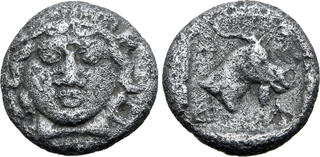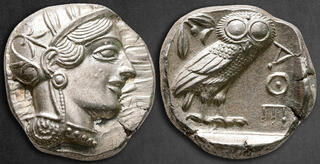Match 1:
Match 2:
| Numismatica Ars Classica > Auction 146 | Auction date: 8 May 2024 |
| Lot number: 2127 Price realized: This lot is for sale in an upcoming auction - Bid on this lot  | |
| Lot description: The Carthaginians in Italy, Sicily, Sardinia and North Africa. Tetradrachm, uncertain mint in Sicily circa 320, AR 26 mm, 16.80 g. Female head l., wearing oriental tiara with plain band before forehead. Rev. Lion walking l., with head facing; behind, palm tree with three clusters of dates. In exergue, s'mmhnt (People of the Camp) in Punic characters. Rizzo pl. LXVI, 6 (these dies). Jameson 911 (these dies). SNG Lloyd 1628 (these dies). Kraay-Hirmer pl. 73, 209 (these dies). Jenkins Punic Sicily III, 270. Extremely rare and in unusually fine condition for this difficult issue. A masterpiece of Carthaginian coinage of excellent Hellenistic style. Struck on a very broad flan and with a pleasant old cabinet tone. About extremely fine / good very fine Privately purchased from Harlan J. Berk in 1997. Within the large series of Siculo-Punic coins issued for Carthaginian military campaigns in Sicily, the "Queen Dido" tetradrachms are isolated and distinct. They consist of three individual issues, each produced by a single pair of dies, none of which are linked. All three bear the Punic inscription s'mmhnt (people of the camp) and share the same design type, yet each provides details that make it distinctive. Based upon this, it would seem that at least two, perhaps three artists were employed to cut the dies. As Jenkins observed, the engraving style of the "Dido" heads shares features with some other Siculo-Punic issues – a good reason to believe these masterful dies were cut by artists who had worked on other types. The engravers simply modified the familiar, Euainetos-inspired Artemis-Arethusa by the addition of the oriental tiara or Phrygian cap. The results of that modification were spectacular, and they are widely considered to be masterpieces of Sicilian Greek die engraving. Based upon stylistic affinities with other Siculo-Punic tetradrachms, Jenkins concludes they must have been struck in about 320 B.C., or "during the following years". If struck closer to c.315, he notes they may have been produced for Hamilcar, son of Gison, who was then preparing for war against the Syracusan King Agathocles. It is possible they were intended for the elite battalion of 2,000 citizens leading the new armada. The head on the obverse has been the subject of much debate. It is possible that her traditional identification as Dido/Elissa, a historical figure credited with the foundation of Carthage, is accurate. She was the sister of the Tyrian king Pygmalion and a great-niece of Jezebel, wife of King Ahab of Israel, and would have been valued as a founder-figure. In his final analysis, Jenkins identifies her as Artemis-Tanit, for Artemis wears similar headgear on some Attic and Tarentine terracotta of the 4th Century B.C., and on some Sicilian terracotta of the same era she is associated with a lion or a palm tree, or both. He cites bilingual stelae inscribed in Phoenician and Greek which, in some respects, suggest Artemis was the Greek equivalent of Tanit. Such are the current theories, which always are subject to revision with a new observation or the discovery of tantalising evidence. Estimate: 40000 CHF | 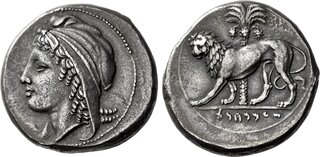 |
Match 3:
| Leu Numismatik AG > Auction 15 | Auction date: 1 June 2024 |
| Lot number: 18 Price realized: This lot is for sale in an upcoming auction - Bid on this lot  | |
| Lot description: BRUTTIUM. Rhegion. Circa 415/0-387 BC. Tetradrachm (Silver, 23 mm, 16.75 g, 12 h). Facing head of a lion. Rev. ΡHΓINON Head of Apollo to right, wearing laurel wreath; behind, olive sprig. Herzfelder 91b and pl. X, 91 (this coin, D54/R78). HN Italy 2496. SNG Copenhagen 1933 (same reverse die). SNG Lockett 658 (same reverse die). Weber 1119 (same reverse die). Beautifully toned and with an exceptional pedigree. Minor porosity, otherwise, good very fine. Ex Hess-Leu 45, 12-13 May 1970, 33 and Hess-Leu 3, 27 March 1956, 54, from the V. J. E. Ryan Collection, Part IV, Glendining, 20 February 1951, 1481 and ex Ratto, 4 April 1927, 319, from the Duplicates of the British Museum, Naville V, 18 June 1923, 757, and from the collection of Charles Butler, Sotheby, Wilkinson & Hodge, 3 July 1911, 61. Hemmed in between the Brettian mountains and the Strait of Messina, Rhegion was founded in the 8th century BC by Chalcidian and Zanklian settlers at the southwestern tip of Italy. The city had scarce fertile hinterland and was accordingly maritime-oriented. Together with its sister city Zankle-Messina, it controlled the strategically crucial Strait of Messina, through which the majority of the maritime trade between the northwestern and eastern Mediterranean was conducted. Its location on the Italian mainland afforded it some protection from the regularly erupting Carthaginian-Greek wars in Sicily, but Rhegion came into conflict with the Syracusan tyrant Dionysios at the beginning of the 4th century BC. An initial siege in 396 BC was repelled, but a lost naval battle in 389 led to a renewed siege of the city, which was finally conquered and destroyed in 387 BC. This also marked the end of the wonderful classical coinage of the city, which depicted the city's emblem, the frontal lion's head, on its magnificent tetradrachms. Estimate: 7500 CHF | 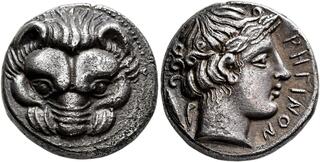 |
Match 4:
| Numismatica Ars Classica > Auction 146 | Auction date: 8 May 2024 |
| Lot number: 2126 Price realized: This lot is for sale in an upcoming auction - Bid on this lot  | |
| Lot description: The Carthaginians in Italy, Sicily, Sardinia and North Africa. Tetradrachm, uncertain mint in Sicily circa 320, AR 26 mm, 17.02 g. Female head l., wearing oriental tiara with plain band before forehead. Rev. Lion walking l., with head facing; behind, palm tree with three clusters of dates. In exergue, s'mmhnt (People of the Camp) in Punic characters. Rizzo pl. LXVI, 7 (these dies). Jameson 911. SNG Lloyd 1628. Kraay-Hirmer pl. 73, 207 (these dies). Jenkins Punic Sicily III, 271. Extremely rare and in exceptional condition for the issue, among the finest specimens known. A portrait of enchanting beauty, the work of a very skilled master engraver, perfectly centred in high relief on very fresh metal and with a lovely light iridescent tone. An unobtrusive metal flaw on cheek and a small mark on lion's body, otherwise good extremely fine Ex NFA XXV, 1990, 44; Sotheby's 26 October 1993, Merrill-Lynch, 17; NAC 10, 1997, 189 and Triton III, 1999, 349 sales. This extraordinary tetradrachm seems to have been struck late in the 4th Century B.C., perhaps between 320 and 310, and very likely in the early part of that range. It belongs to a series containing just three sets of dies, each of which presents this interesting subject matter in a different way. Though each is spectacular and original in its own right, if one set of dies had to be chosen as the most accomplished, it certainly would be the one used to strike this coin. In his die study of the Siculo-Punic series, Jenkins was hard-pressed to find a place for this group among the other series of tetradrachms. Even if the superior style of engraving and the unusual subject matter were not obvious considerations, the fact that only three sets of dies were used and that they do not link with other issues (or even within themselves) demonstrates it was a special and isolated series. Aspects of the engraving style led Jenkins to conclude that they belonged at the end of his series 2d (head of Kore/horse animated before palm tree) or the beginning of his series 3 (dolphins around the head of Arethusa/horse head and palm tree). If linked with Jenkins' series 3, this coinage might be associated with preparations by the Carthaginian leader Hamilcar (son of Gison) to combat Agathocles; as such, Jenkins suggests they may have been minted for the 2,000 elite citizens who headed the new Carthaginian armada. A convincing interpretation of the designs has thus far been impossible to achieve. The head was traditionally described as Dido (Elissa), the legendary foundress of Carthage, but that identification has not found much support in recent decades. She may also be the personification of Libya, for that would match well with the prowling lion on the reverse. Jenkins objects to that idea, however, noting that celebrating an indigenous people subject to Carthaginian rule would not have been "consistent with Carthaginian nationalism". To the contrary, Robinson suggests Libya would have been an ideal subject if the bulk of the Carthaginian army at this time were comprised of mercenaries from Carthaginian Libya. Another possibility is that the Punic goddess Tanit (being in some ways the equivalent of the Greek goddess Artemis) is represented, and in many respects she seems to be the best choice. Estimate: 100000 CHF | 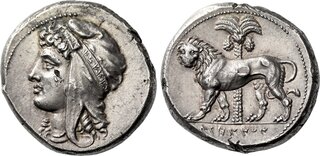 |
Match 5:


